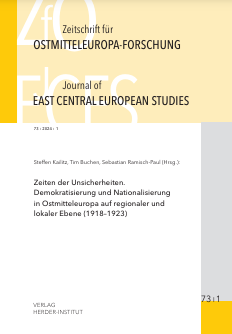Vom „erfolgreichen Durchdringen des nationalen Gedankens“ und dem „Sieg der demokratischen Grundsätze“. Deutungsmuster von Nation und Demokratie in Oberschlesien, dem Teschener Schlesien und der Orava (1918/19)
About the “Successful Penetration of the National Idea” and the “Victory of Democratic Principles”. Patterns of Interpretation of Nation and Democracy in Upper Silesia, Teschen Silesia and the Orava (1918/19)
Author(s): Sebastian Ramisch-Paul, Matthäus WehowskiSubject(s): Political history, Government/Political systems, Pre-WW I & WW I (1900 -1919)
Published by: Verlag Herder-Institut
Keywords: nationalism; democracy; region; state-building; border regions;
Summary/Abstract: After the end of World War I, Eastern Europe entered a period of upheaval. The continental empires dissolved and new nation-states emerged. Following the ideas of Woodrow Wilson, democratization became the dominant political concept. But the meaning of “democracy” was unclear, and many different political groups claimed sovereignty over its interpretation. In this article, we want to take a closer look at the border regions between the newly emerging nation-states of Germany, Czechoslovakia, and Poland, which were characterized by a high degree of ethnic, religious, and social diversity. These border regions were also characterized by different experiences with politics, especially with voting rights and political parties. Despite their relative geographic proximity, Upper Silesia, Teschen Silesia, and Orava had very different political histories, being part of Prussia, the Austrian Crown Lands, and the Kingdom of Hungary. While voting rights in the Kingdom of Hungary were severely restricted, the Austrian Crown Lands had universal male suffrage since 1907. In many cases, the concept of national belonging was very different from the political centers and often had a strong regional connotation—with regionalist movements claiming the idea of “self-determination” for themselves. Thus, the regional conceptions of democracy and nationality that emerged in the brief period of 1918/19 are often unique and overlooked.
Journal: Zeitschrift für Ostmitteleuropa-Forschung
- Issue Year: 73/2024
- Issue No: 1
- Page Range: 51-83
- Page Count: 34
- Language: German

